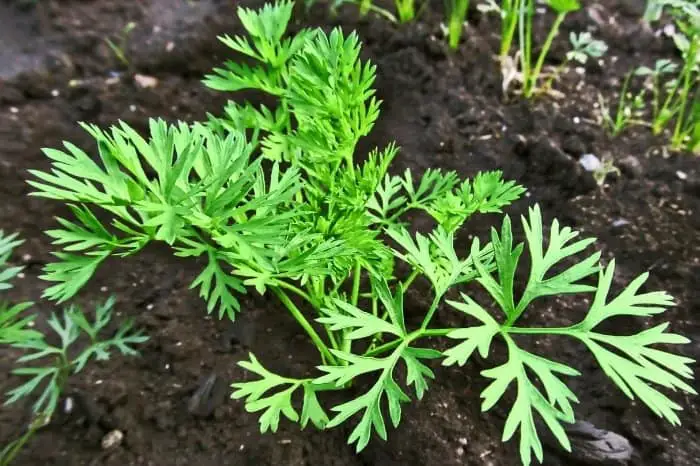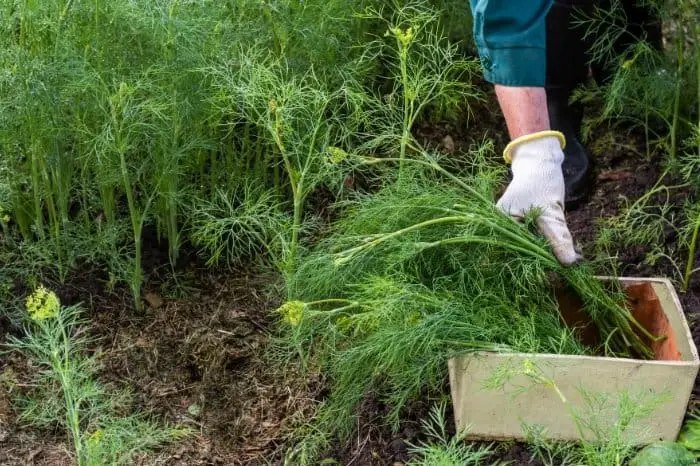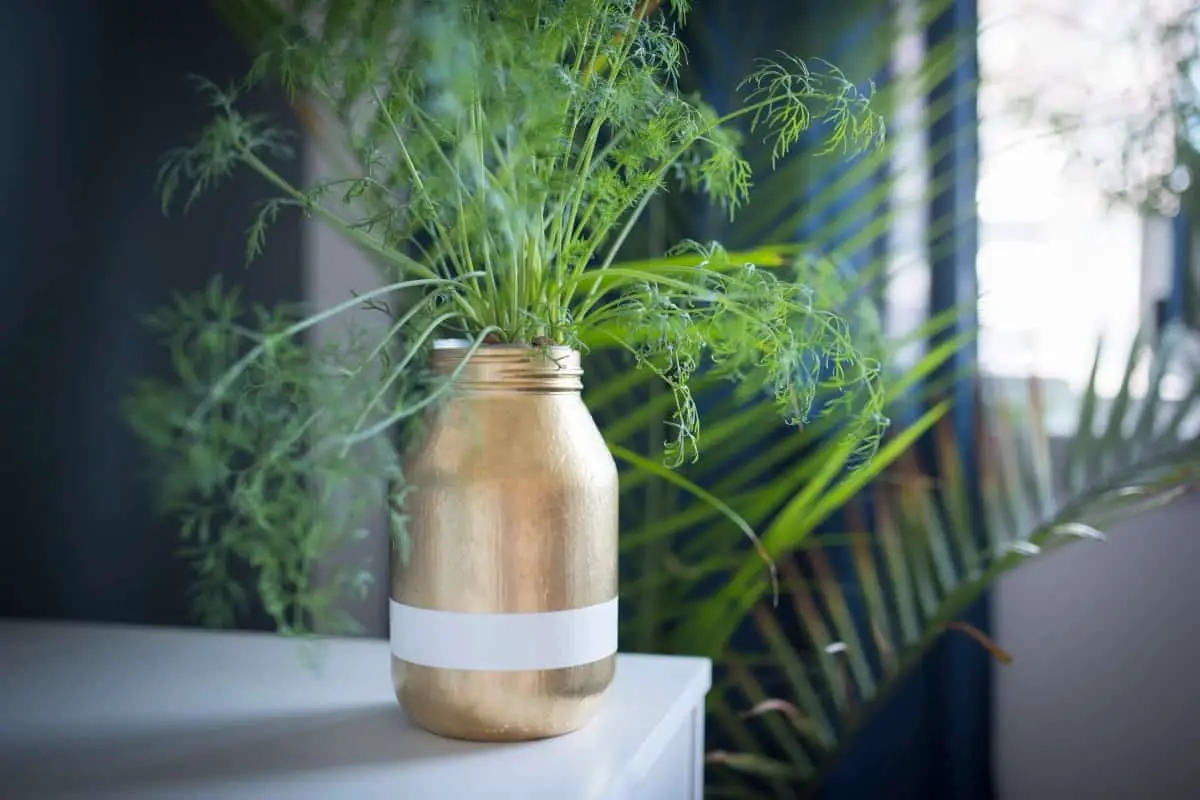Last Updated on January 17, 2023 by Urska
Growing dill from seeds can be difficult for some gardeners, even experienced ones who do not really know how to grow this tasty herb.
Dill is popularly known for its tasty feathery leaves that bring out salmon’s perfect taste. It is also known as dill weed and has a growing reputation for being tricky to grow. If you pay attention to its preferred growing conditions, you can easily and successfully grow it from seed.
Dill was initially grown as a medicinal herb and used as a remedy for headaches, coughs, and easing flatulence. Today it is commonly used in the kitchen – the seeds, the leaves, and even its pretty flowers.
Growing Dill
Before you start growing dill, there are a couple of things you should know.
-
-
First, dill is a cool-season herb that withstands temperatures up to 25 degrees Fahrenheit and can grow in USDA hardiness zones 2 to 11. This means it is accessible to North American gardeners and grows best during the spring season. As soon as the frost has passed and you can work your soil in the spring season, it is time to get your dill seeds for planting ready.
-
Second. This herb though annual has the ability to self-seed. When seeds from mature plants fall on the ground, they happily grow into full-sized plants in the coming season without any help from you. That said, if you plant this herb once, you may not need to produce it again.
-

Growing Dill From Seeds
You can grow dill seeds indoors starting early spring or sow them directly outside beginning from May to July.
To grow dill indoors, use cell trays for individual seeds or scatter them thinly in a small pot. Start them at least 6 to 8 weeks before the last frost. Ensure that you provide them with temperatures ranging between 16 to 18 degrees centigrade. Within 14 to 21 days, your seeds should have germinated.
When the seedlings grow to a few inches tall, thin out the weaker ones so that there is one plant spaced every 4 inches. The weaker ones should be consumed; they will still carry the strong dill flavor.
Once your seeds are ready, transfer them outside, hardening them off for a week to 10 days after the frost is over. Plant the seedlings at least 12 inches apart.
If you live in a dry area, you can leave your dill plants 4 inches apart. However, if you live in a more humid area, allow 6 inches between each plant instead.
Providing plants with ample extra room allows for better air circulation and helps prevent disease, and still allows you to maximize your harvest.
Plant your dill in full sun but for hotter areas, choose a sunny or part shady location. To get a steady supply of fresh dill throughout the season, plant in early spring, again in June, and once more in July.
Growing Dill From Seeds Successfully
-
-
Choose the Right Location. Dill thrives in a sunny sheltered site. It loves rich, well-draining soil and requires regular watering, especially in the hot season.
-
Preparation for Transplanting. Before transplanting your dill seedlings, add compost or well-rotted manure to your soil to add more nutrients and help it retain moisture.
-
Amount of Water Needed. Be careful not to overwater your plants because they will not thrive if waterlogged.
-
Check Out When Are Tomatoes Ready To Pick
Dill Cultivars To Grow
Dill offers various uses – you can grow it for foliage, for seeds, or just for garden beautification. Some cultivars do well in particular areas than others.
Some cultivars are slower to bolt, meaning you enjoy a more extended harvest of leaves. Others seed earlier, providing you with seed heads at an earlier date. These cultivars also have height variations as well.
Bouquet
‘Bouquet’ variety flowers early producing an abundance of seeds. This is an excellent choice if you want a lot of fresh-cut flowers or seeds for your kitchen. This cultivar can reach up to 24-36 inches tall at maturity with a 4- to 8-inch spread. It is ready to harvest in 40-60 days.
Elephant
‘Elephant’ variety is late-flowering, meaning you will have delicious fresh dill weed throughout the growing season. This cultivar grows up to 30-48 inches in height and has a 16- to 24-inch spread. It matures in 60-90 days.
Herb Seeds Vault [10 Variety – 3000 Seeds]- Heirloom Non GMO

Hera
‘Hera’ variety is a bunching dill producing lots of fragrant foliage that bolts slower than many varieties. This cultivar is a smaller type, reaching 18-24 inches in height with a spread of 8-12 inches. It reaches maturity in 40-60 days.
Caring For Dill
Dill requires a little bit of care to provide you with the best results.
-
Watering. Water your dill plant seeds until they are well established. Once established, they will thrive if the soil is dry in between waterings.
-
Fertilizing. Fertilize your soils using aged compost. Once established, side-dress your deal seedlings two to three times during the growing season with compost tea.
-
Staking and Weeding. Staking is essential to keep your dill tall and wispy. Remove weeds so that they don’t compete for nutrients and water with your plants. Pinch out early flowers from the deal plants to ensure prolonged leaf growth.
-
Container Size. Dill forms taproot that requires a deep container in order to thrive. If you grow dill in a container, choose at least 12 inches deep.
-
Winter Care. You can grow your dill indoors during winter as it is likely to die back to the ground after the first frost.
Harvesting Dill
It is best to harvest dill leaves before the flowers open or about 70 days after sowing. During this time, they have the best flavor.
Snip your fresh dill leaves or stems using scissors it a sharp knife during the growing season when your plants reach about 8 inches tall.

Dill seeds are ready for harvest about 90 days after sowing seeds. The seeds should be flat and brown by the time you harvest them; ensure you pick them before they fall to the ground. Collect the flower heads and hang them in a paper bag.
Read more about Does Oregano Come Back Every Year?
Does Dill Grow Back Every Year?
Dill is a biennial plant that guy’s back to the ground during winter and reappears in the spring. However, very harsh winter can kill the plants, with none reappearing in the spring.
If you grow dill indoors in a container, keep it going all year round by bringing it indoors during the harsh winter months.
Conclusion
As we have seen above, growing dill from seeds is easy and requires low maintenance. This encourages every new and old gardener to keep growing this fresh herb for use in your different recipes.
Caroline is a gardener who loves to get down to the nitty–gritty of gardening. She proudly proclaims herself as a ‘dirt worshipper‘ and can often be found deep in the garden, covered in soil and singing to her plants. As a self–proclaimed ‘plant whisperer‘, Caroline believes that plants need love and attention just like any other living thing, and she loves to give them both. When she‘s not tending to her garden, you can often find her researching the latest gardening trends, or teaching others how to make their gardens thrive


